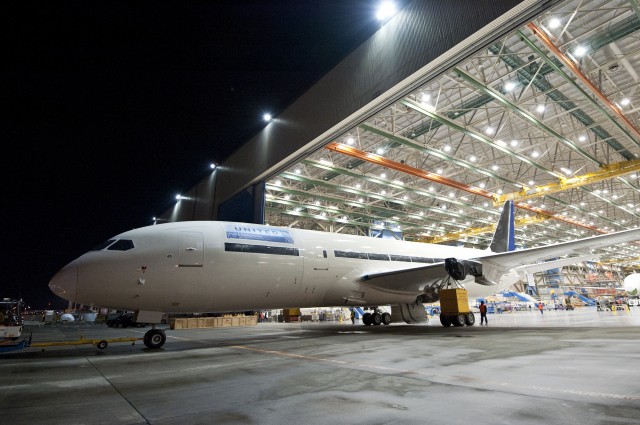
United's first Boeing 787 Dreamliner is pulled out of the factory. Image from Boeing. Click for Larger.
Wednesday night, Boeing pulled out United Airline’s first 787 Dreamliner from the factory and off the final assembly line. The first 787 Dreamliner has already been delivered to the launch customer, ANA, but United will be the first North American airline to take delivery of the new aircraft. From United’s press release: “While in final assembly, the aircraft moved through four factory positions, including the final aircraft body join, landing gear installation, weight-on-wheels testing and installation of interior components and systems. Over the next several months, the aircraft will move to the next phase of completion, which includes final cabin configuration, installation of engines and painting.”
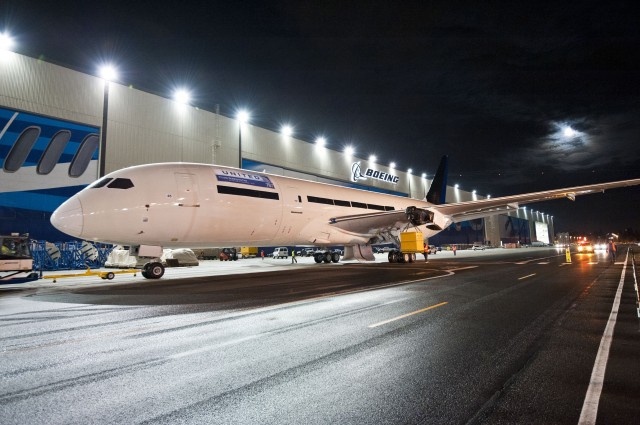
United's first Boeing 787 Dreamliner gets pulled in front of the factory located in Everett, WA. Photo by Boeing. Click for larger.
United will configure their first 787 with 36 seats in BusinessFirst, 63 seats in Economy Plus and 120 seats in Economy. There was some speculation if United might be offering a special livery, but I doubt it. When I was on the factory floor recently, the tail was definitely a solid blue, which matches United’s current “new” livery. With United recently switching their brand over from the tulip to the globe, it wouldn’t really make sense for them to also introduce a special livery. Normally I am all for any livery that spices things up, but at this stage it would just cause brand confusion.
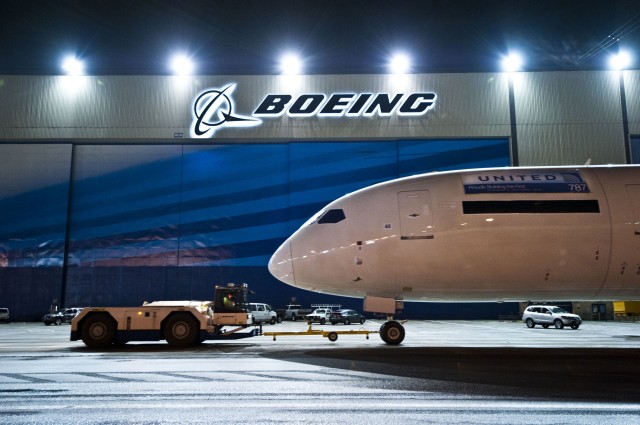
Nose show of United Airline's first Boeing 787 Dreamliner outside the factory at Paine Field. Photo by Boeing. Click for larger.
Although the exact date of delivery is unknown, United told AirlineReporter.com that they expect to get their first 787 during the, “second half of 2012.” It will be the first of 50 that the airline has on order.
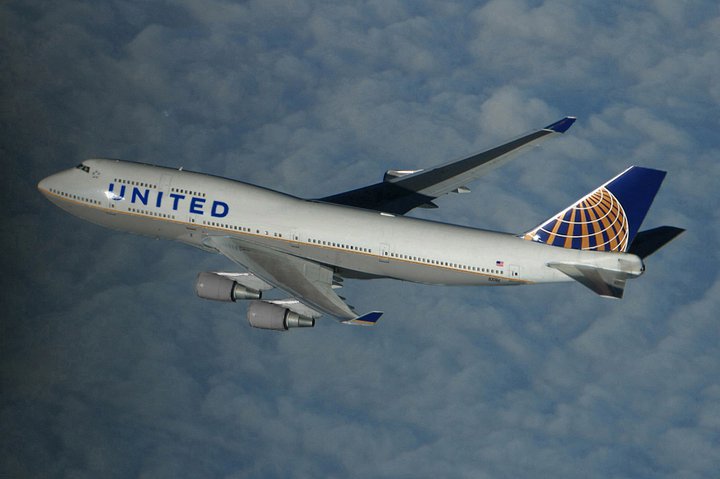
The new United Airlines livery on a Boeing 747.
We have seen the new United livery on a Boeing 737, but now we can see it on the Boeing 747. You know what? The more I see this livery the more I get used to it and the more I like it. I especially like this photo since we are not use to seeing these old Continental colors on a Boeing 747. How about you? Are you liking this new combined livery more?
Update: This photo is in fact a photoshop. I apologize for posting it saying it was a real photo, I was fooled as well. But it still shows very closely what the new United livery will look like on the Boeing 747.
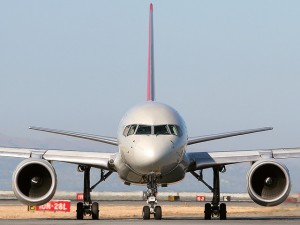
Northwest Airlines Boeing 757
There has been a lot in the news about airline mergers and buy outs. Delta & Northwest, United & Continental and most recently AirTran & Southwest. Some in the media throw around “merger” and “takeover” interchangeably, but they are very different. When two airlines come together, there are two types of sale agreements: the merger and the takeover.
I got an email from a reader (thanks Jay) asking about the difference between an airline merger and take over. I am not a financial professional, but I want to try my best to point out the major differences. If you have any more to add, please feel free to leave a comment!
MERGER:
This is when two companies come together blending their assets, staff, facilities, and so on. After a merger, the original companies cease to exist, and a new company arises instead. Sometimes the new entity will take the name and brand from one of the airlines, but sometimes an entirely new brand can be created.
Delta and Northwest merged, leaving the Delta brand. United and Continental merged, which will leave the United brand. In mergers like these, management needs to work hard to come to certain agreements, figure what/who will be cut and how the new airline will operate. Of course, this can be a very complex process for both airlines to undertake.
TAKE OVER / BUY OUT / ACQUISITIONS
In a takeover, a company is purchased by another company. The purchasing company owns all of the target company’s assets including company aircraft, trademarks, routes and so forth. The original company may be entirely swallowed up, or may operate semi-independently under the umbrella of the acquiring company.
In the case of Southwest buying out AirTran, the AirTran brand will disappear and be absorbed by Southwest. It is not a merger and Southwest will own the assets of AirTran and have complete control. This process is easier than a merger, since management at Southwest has the final say, but they need to successfully share their culture with the employees at AirTran and make sure they feel welcome.
Alright, I hope that helps some!
Image: fiveholer

How big of a shirt do we need to show all the fees we pay too?
There are some pretty crazy fees for airlines now-a-days. From checking a bag, to getting a pillow. But these are some of the weirdest (and some dumbest) ones I have seen.
- Spirit Airlines was charging a $2.50 “natural occurrence interruption fee” to try to re-capture losses from weather. They also had an $8.50 “international service recovery fee” meant to get money for having international destinations. The US DOT gave them a $40,000.00 fine and made them take down the non-advertised fees.
- Allegiant Air charges a “convenience fee” of $13.50 for getting a ticket on their website. Which goes against the industry standard now of charging people to NOT book on the website.
- Ryaair charges about $7 per passenger for a “payment handling fee” no matter how you end up booking the ticket.
- United charges a $349 flat annual fee for frequent flyers (and companion) to fly in the Economy Plus in the front of the plane whenever possible.
- In the CRAZIEST fee I have seriously heard of (have always heard people joke about this), Ryanair chief executive Michael O’Leary says they are looking to charge for bathroom usage. “Eventually it’s going to happen. It’s just we can’t do it at the moment because we don’t have a mechanism for charging you,” he said. Although, mostly a well-crafted publicity stunt (yes, I know I am guilty of writing about it and furthering their agenda), but it shows that maybe someday, some airline will be silly enough to try this.





